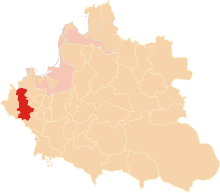Kalisz Voivodeship (1314–1793)
| Kalisz Voivodeship Palatinatus Calisiensis ( | |||||||||
|---|---|---|---|---|---|---|---|---|---|
| Voivodeship of Poland¹ | |||||||||
| 1314–1793 | |||||||||
 Kalisz Voivodeship in the Polish–Lithuanian Commonwealth in 1635. | |||||||||
| Capital | Kalisz | ||||||||
| Area | |||||||||
• | 15,320 km2 (5,920 sq mi) | ||||||||
| History | |||||||||
• Established | 1314 | ||||||||
| 1768 | |||||||||
| 25 September 1793 | |||||||||
| Political subdivisions | Counties: six until 1768, then three | ||||||||
| |||||||||
| ¹ Voivodeship of the Kingdom of Poland before 1569. | |||||||||
Kalisz Voivodeship 1314–1793 (
The territory of the voivodeship remained unchanged from 1314 until 1768, when Gniezno Voivodeship was carved out of its northern three counties. Its original area was 15,320 km2., but after 1768 it shrank to 7,810 km2 (3,020 sq mi). Local starostas resided at Kalisz, Gniezno, Konin, Kcynia, Naklo, Pyzdry, and Złotów. Kalisz Voivodeship had eight senators. These were: Archbishop of Gniezno, Voivode of Kalisz (who resided at the Kalisz Royal Castle), Castellan of Kalisz, Castellan of Gniezno, and Castellans of Ląd, Nakło nad Notecią, Biechowo, and Kamieńsk.
Zygmunt Gloger in his monumental book Historical Geography of the Lands of Old Poland gives a detailed description of Kalisz Voivodeship:
"Kalisz Voivodeship made eastern half of Greater Poland proper (...) In the
Kalisz Voivodeship, together with Poznań Voivodeship had its sejmiks at Środa Wielkopolska, where each province elected six deputies to the Sejm, and two deputies to the Greater Poland Tribunal at Piotrków Trybunalski (...) Land court was at Kalisz, as well as town court for the counties of Kalisz, Kamieńsk and Pyzdry (...) The voivodeship had eight senators, while local starostas were located in several towns, such as Kalisz, Gniezno, Pyzdry, Konin, Kcynia, Ujście, Powidz, Odolanów, Kłecko, Pobiedziska, and Kolo (...) Among historic towns of the voivodeship were Kalisz, Gniezno, Lad, Wągrowiec, Mogilno, and Trzemeszno".
Greater Poland general governor (Starosta Generalny) seat:
Voivodeship governor (
Voivodes:
- Zygmunt Grudziński (1628–1652)
Regional council (Sejmik) seat:
General council (Sejmik Generalny) for the Greater Poland seat:
Administrative division (till 1768):
- Kalisz County (Powiat Kaliski), Kalisz
- Konin County (Powiat Koniński), Konin
- Pyzdry County (Powiat Pyzdrski), Pyzdry
- Gniezno County (Powiat Gnieżnieński), Gniezno
- Kcynia County (Powiat Kcyński), Kcynia
- Nakło County (Powiat Nakielski), Nakło
In 1768 counties of Gniezno, Kcynia and Nakło were transferred to the newly created Gniezno Voivodeship. As a result, in final years of the Polish–Lithuanian Commonwealth, Kalisz Voivodeship consisted of the following three counties:
- Kalisz County (Powiat Kaliski), Kalisz
- Konin County (Powiat Koniński), Konin
- Pyzdry County (Powiat Pyzdrski), Pyzdry

